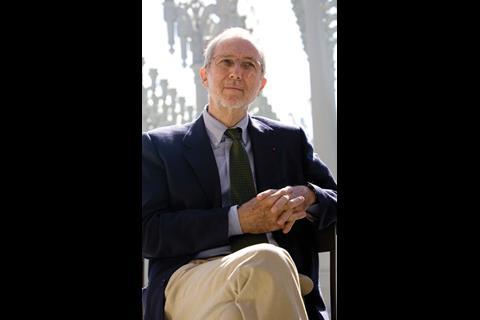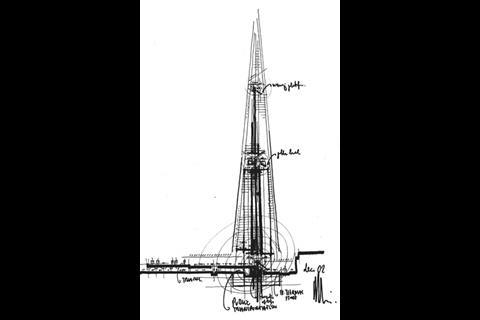You may be one of those who think Renzo PianoŌĆÖs Shard in the City of London is just pie in the sky, but the architect himself has no doubts. Besides, heŌĆÖs got friends in high places. By Dan Stewart
Renzo PianoŌĆÖs head is in the clouds. He is daydreaming about the church he plans to build at the top of the Shard: ŌĆ£I always thought it would be nice to have a place of meditation up there. It would not need to be a church, as such, but somewhere to go and sit.ŌĆØ
Many ŌĆ£starchitectsŌĆØ come across as lofty, self-involved individuals in the flesh, so obsessed with the conceptual that it is difficult to engage them on a practical level. But for all his talk of places to go and sit in the sky, Piano is a down-to-earth pragmatist, more obsessed with materials than with meditation. He builds a small replica ŌĆō a ŌĆ£mock-upŌĆØ, in his own words ŌĆō of each of his designs before construction begins to ensure the building turns out exactly the way he wants it to look.
ŌĆ£Sometimes I have to explain this to the client,ŌĆØ he says with a smile, ŌĆ£but when I explain, they understand. If you donŌĆÖt explore, you donŌĆÖt find new things.ŌĆØ
Born in Genoa in 1937, Piano remains true to his Italian roots and still has a home and office there. He trained at the Politecnico di Milano where he later taught, before going on to work alongside other architectural greats, including Louis Kahn and Richard Rogers, with whom he joined forces to design the Pompidou Centre in Paris in 1977.
Over the past 30 years Renzo and his practice, Renzo Piano ║├╔½Ž╚╔·TV Workshop, have designed a dizzying variety of projects. There are not many signature architects who can boast airports (Kensai in Japan), shopping centres (Bercy in Paris) and football stadiums (Bari in Italy) on their CVs.
In his 70th year, Piano is still going strong, with an increasing focus on buildings in the UK ŌĆō the reason for his flying visit to London last month. He is designing not only MaceŌĆÖs Shard in the City of London, but also a brightly coloured office scheme at Central St Giles in the shadow of Richard SeifertŌĆÖs Centre Point tower. Here, in a rare free slot, he talks 9/11, the Shard and Ken Livingstone ŌĆō though Boris Johnson still appears something of a mystery to him.
Stanhope development director Mike Knowles is working with PianoŌĆÖs workshop on Legal & General and MECŌĆÖs Central St Giles development. ŌĆ£ItŌĆÖs a personal approach,ŌĆØ he says. ŌĆ£HeŌĆÖs a down-to-earth and engaging individual, whoŌĆÖs more than happy to talk to people, and he takes a detailed craft-based approach to developing the project. He doesnŌĆÖt stick rigidly to his ideas, which can be the case with high-profile architects. WeŌĆÖve really enjoyed the creative process with him.ŌĆØ
ItŌĆÖs a measure of this trust and respect that Piano was the first architect to be commissioned to build a tower in post-9/11 New York, the recently completed New York Times HQ. Amazingly, Piano was awarded that contract on 11 September 2001: ŌĆ£It was very emotional because it was such a tragedy. We had to rethink completely how we do tall buildings.ŌĆØ
Although work on the tower didnŌĆÖt begin until New York felt confident enough to start to move on, which was two years after the attack, Piano says there was still plenty of opposition to the 52-storey scheme. ŌĆ£The real problem was that the people who wanted to rebuild the city thought it was the fault of the towers and not the terrorists,ŌĆØ he says. ŌĆ£People blamed the towers for collapsing.ŌĆØ
In London, there is a medieval tradition that needs to be understood. It is the British way
He rejects the idea that the threat of attack should affect the design of a signature building. ŌĆ£The temptation in circumstances like this is to design a self-defensive building,ŌĆØ he says. ŌĆ£But the only building that is resistant to a terrorist attack is, of course, a bunker, underground. The real big adventure was to escape from that thinking.ŌĆØ
The result is a building traditional in its ambition, but forward-looking in its treatment. Clad in white ceramic rods, the New York Times HQ is a beacon on the Manhattan skyline. Piano is pleased with the result. ŌĆ£The owners like it, the people love it. They trusted us to build a building that is safe, and yet transparent. It works very well.ŌĆØ
After such groundbreaking work in Manhattan, Piano now has his sights set on London, and perhaps his most famous commission in recent years ŌĆō the Shard of Glass. The designs for the 310m tower had a frostier reception than the New York Times HQ, with English Heritage (EH) calling it in for a public inquiry. Although he once described EH as ŌĆ£perverse,ŌĆØ he now claims some kinship with the public body. ŌĆ£In Manhattan, you have a generation of people who know towers, who understand a landscape of tall buildings,ŌĆØ he says. ŌĆ£In London, there is a medieval tradition that needs to be understood. It is the British way.ŌĆØ
As regular readers of ║├╔½Ž╚╔·TV will know, doubts remain as to the ShardŌĆÖs financial viability, with many commentators not believing it will ever see the light of day. But Piano is so sure it will be built he has already started to build a large mock-up of the facade in a field in Genoa; the idea is to examine how it reflects light. ŌĆ£The light will change from wherever you are,ŌĆØ Piano says.
Like many other tall buildings, the Shard has been labelled unsustainable. The energy footprint of the 66-storey tower will be huge, and it has long been recognised that glass buildings are difficult to make sustainable. But Piano is quick to defend the project: ŌĆ£The sustainability of this building is as much in its position as in its construction. There will be no car parking spaces here. I would not have designed it if it were not on top of a train station.ŌĆØ
And though he may be daydreaming today, PianoŌĆÖs church will not remain just an idle concept. He and the Right Reverend Tom Butler, the Bishop of Southwark ŌĆō ŌĆ£a good friend of mineŌĆØ ŌĆō are to make it an official submission. ŌĆ£The building will be a living city, with hotels, and apartments, and businesses. Why should it not have a church too?ŌĆØ he asks. ŌĆ£Ken Livingstone has been very supportive.ŌĆØ
That may be so, but Livingstone is no longer in charge of London. That responsibility now rests with Boris Johnson, whose attitude to tall buildings has been less than supportive. So what does Piano think of Boris? He looks bemused. ŌĆ£Who is this?ŌĆØ Boris Johnson? Blond hair? Buffoonish? Piano shrugs, and smiles again. ŌĆ£I donŌĆÖt know him.ŌĆØ
ItŌĆÖs difficult to tell whether this is true, or whether perhaps PianoŌĆÖs head is back in the clouds.
Postscript
For more on Renzo Piano, search






























No comments yet